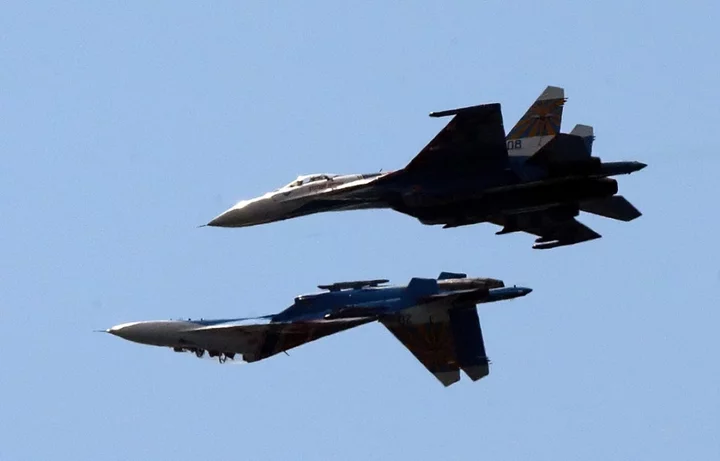A Russian pilot fired two missiles towards an RAF surveillance plane after mistakenly believing he had permission to fire. Following the incident last September, Russia claimed it had been caused by a “technical malfunction” with the UK’s Ministry of Defence publicly accepting their explanation. However, intercepted communications reveal that one of the Russian pilots believed he had been given permission to target the aircraft following an ambiguous command from a Russian ground station. The two Russian SU-27 fighter jets had encountered the RAF plane, which was carrying a crew of up to 30 people, as it was flying a surveillance mission over the Black Sea in international airspace on 29 September. Three Western defence sources with knowledge of the incident have told the BBC that the two Russian pilots received words to the effect of “you have the target”. This prompted one of the pilots to release an air-to-air missile, which successfully launched but failed to strike its target. A row then broke out between the two Russian pilots, as the second did not believe they had been given permission to fire. However, a second missile was released but simply fell from the wing - suggesting the launch was aborted or the weapon malfunctioned. As the Rivet Joint is loaded with sensors to intercept communications, the RAF crew would have been able to listen in to the incident which could have resulted in their own deaths. After the Russian Ministry of Defence called it a “technical malfunction”, the UK government confirmed the incident had taken place. In a statement to MPs on 20 October, the former Defence Secretary Ben Wallace described it as a “potentially dangerous engagement”. However, he added: "We do not consider this incident to constitute a deliberate escalation on the part of the Russians, and our analysis concurs that it was due to a malfunction." An intelligence leak, published online by US airman Jack Teixera, revealed that the US miliary spoke of the incident as a “near shoot-down”. “The incident was far more serious than originally portrayed and could have amounted to an act of war,” the New York Times reported. The MoD has now told the BBC that “this incident is a stark reminder of the potential consequences of Putin’s barbaric invasion of Ukraine.” Read More South Korea expresses 'concern and regret' over military cooperation talks between Kim and Putin What is a Storm Shadow cruise missile? Weapons, spy satellites and nuclear ambitions: what we learned from Putin’s summit with Kim Jong-un in Russia The Body in the Woods | An Independent TV Original Documentary The harrowing discovery at centre of The Independent’s new documentary
A Russian pilot fired two missiles towards an RAF surveillance plane after mistakenly believing he had permission to fire.
Following the incident last September, Russia claimed it had been caused by a “technical malfunction” with the UK’s Ministry of Defence publicly accepting their explanation.
However, intercepted communications reveal that one of the Russian pilots believed he had been given permission to target the aircraft following an ambiguous command from a Russian ground station.
The two Russian SU-27 fighter jets had encountered the RAF plane, which was carrying a crew of up to 30 people, as it was flying a surveillance mission over the Black Sea in international airspace on 29 September.
Three Western defence sources with knowledge of the incident have told the BBC that the two Russian pilots received words to the effect of “you have the target”.
This prompted one of the pilots to release an air-to-air missile, which successfully launched but failed to strike its target. A row then broke out between the two Russian pilots, as the second did not believe they had been given permission to fire.
However, a second missile was released but simply fell from the wing - suggesting the launch was aborted or the weapon malfunctioned.
As the Rivet Joint is loaded with sensors to intercept communications, the RAF crew would have been able to listen in to the incident which could have resulted in their own deaths.
After the Russian Ministry of Defence called it a “technical malfunction”, the UK government confirmed the incident had taken place.
In a statement to MPs on 20 October, the former Defence Secretary Ben Wallace described it as a “potentially dangerous engagement”.
However, he added: "We do not consider this incident to constitute a deliberate escalation on the part of the Russians, and our analysis concurs that it was due to a malfunction."
An intelligence leak, published online by US airman Jack Teixera, revealed that the US miliary spoke of the incident as a “near shoot-down”.
“The incident was far more serious than originally portrayed and could have amounted to an act of war,” the New York Times reported.
The MoD has now told the BBC that “this incident is a stark reminder of the potential consequences of Putin’s barbaric invasion of Ukraine.”
Read More
South Korea expresses 'concern and regret' over military cooperation talks between Kim and Putin
What is a Storm Shadow cruise missile?
Weapons, spy satellites and nuclear ambitions: what we learned from Putin’s summit with Kim Jong-un in Russia
The Body in the Woods | An Independent TV Original Documentary
The harrowing discovery at centre of The Independent’s new documentary

